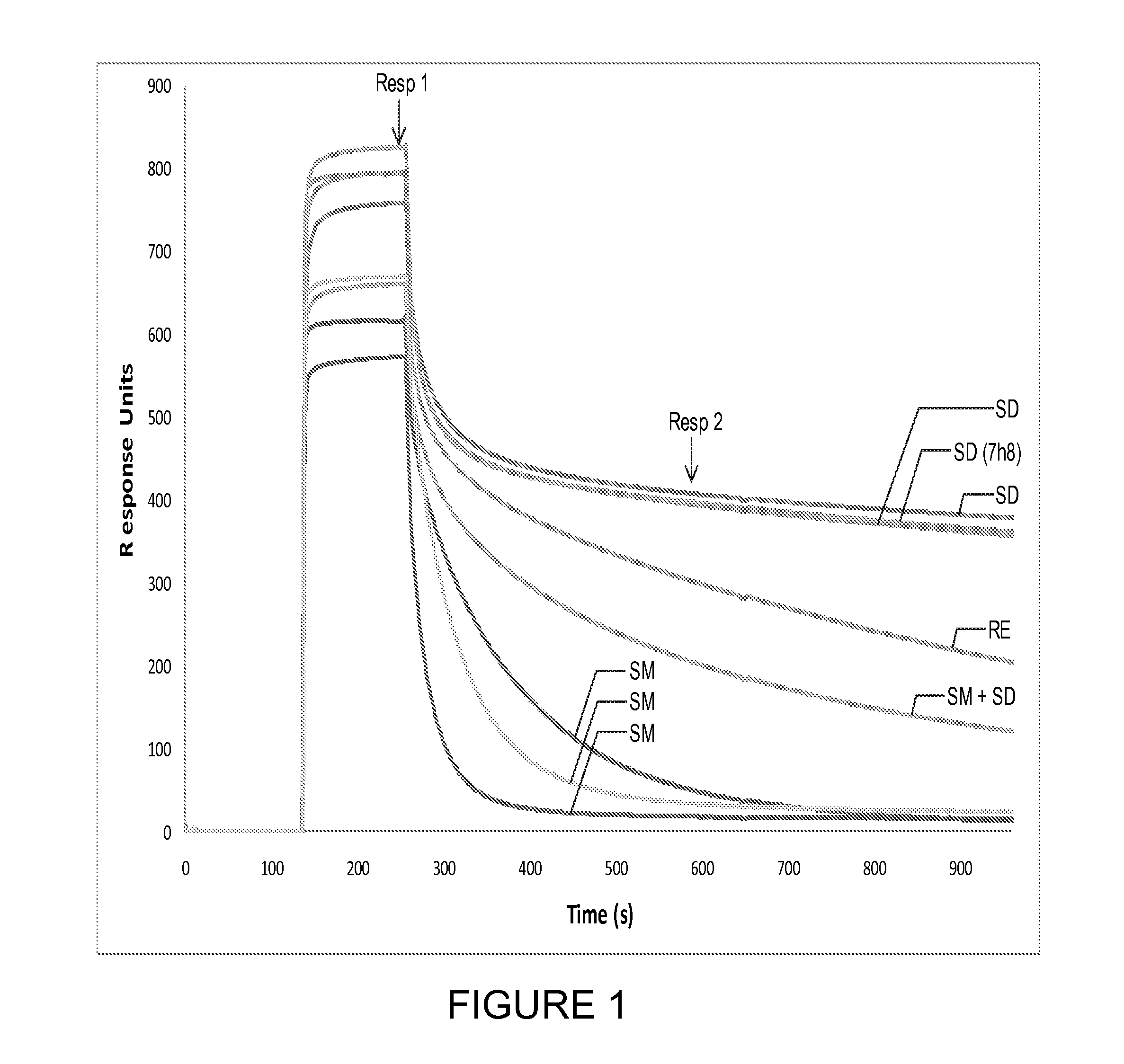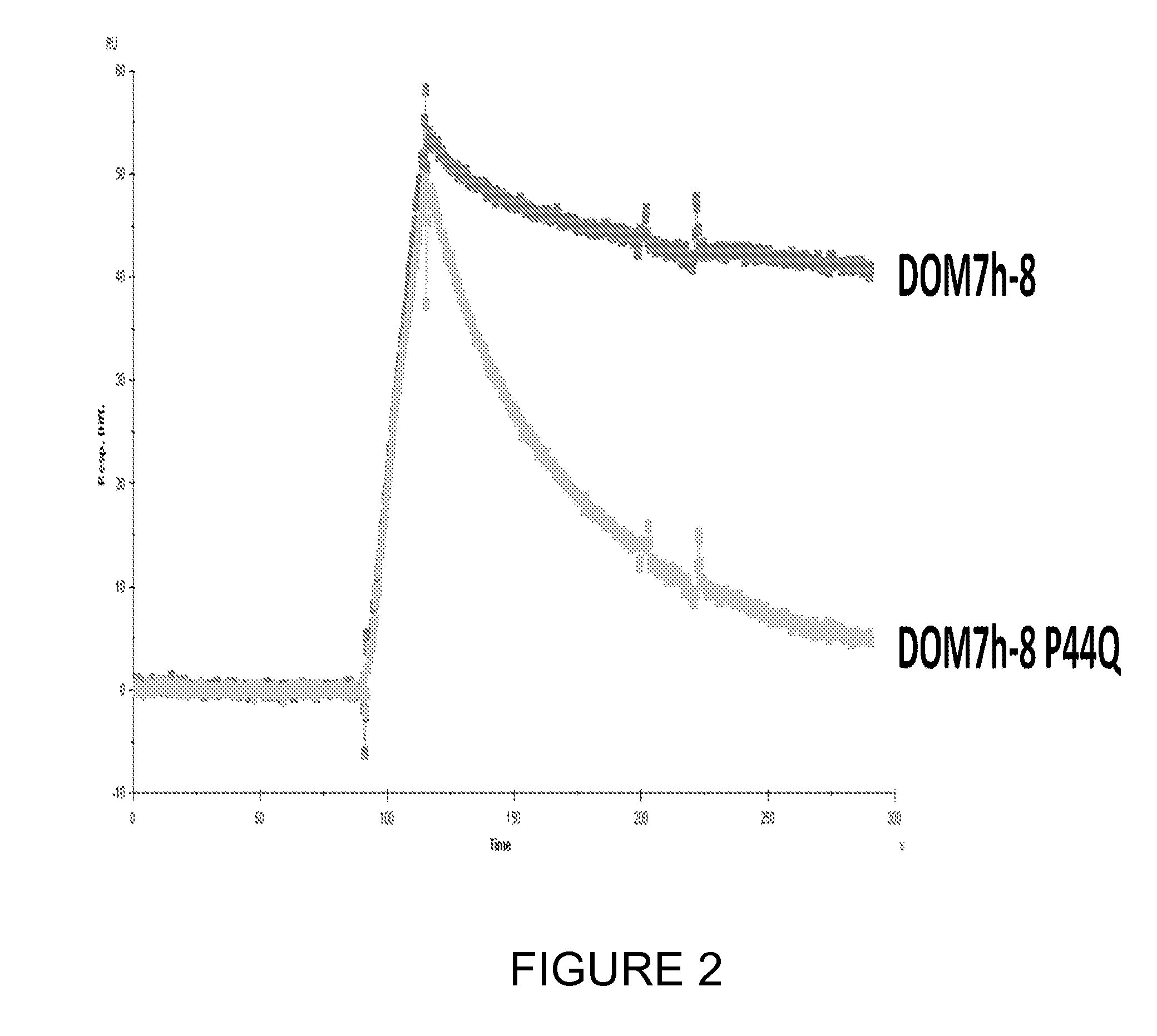Binding domains
a binding domain and domain technology, applied in the field of immunoglobulin, can solve the problems of increasing the likelihood of receptor agonism and detrimental receptor signaling
- Summary
- Abstract
- Description
- Claims
- Application Information
AI Technical Summary
Benefits of technology
Problems solved by technology
Method used
Image
Examples
example 1
Effect of A43D Mutation in Different VL Immunoglobulin Single Variable Domains
[0088]A number of dAbs with binding affinities to antigens were taken and mutations introduced to replace amino acid at position 43 (A) with D. Mutations were introduced using site directed mutagenesis.
[0089]The following dAbs were taken:
PEP1-5-19 (anti-TNFalpha dAb):(SEQ ID NO: 1)DIQMTQSPSSLSASVGDRVTITCRASQSIDSYLHWYQQKPGKAPKLLIYSASELQSGVPSRFSGSGSGTDFTLTISSLQPEDFATYYCQQVVWRPFTFGQGTKVEIKRDOM15-10 (anti-human VEGF dAb)(SEQ ID NO: 2)DIQMTQSPSSLSASVGDRVTITCRASQWIGPELSWYQQKPGKAPKLLIYHTSILQSGVPSRFSGSGSGTDFTLTISSLQPEDFATYYCQQYMFQPRTFGQGTKVEIRRDOM13-25-3 (anti-CEA dAb)(SEQ ID NO: 3)DIQMTQSPSSLSASVGDRVTITCRASQSIGPWLSWYQQKPGKAPKLLFYQVSRLQSGVPSRFSGSGSGTDFTLTIISLQPEDFATYYCQQNLAPPYTFGQGTKVEIKRDOM9-155-25 (anti-IL-4 anti Fcn dAb)(SEQ ID NO: 4)DIQMTQSPSSLSASVGDRVTITCRASRPISDWLHWYQQKPGKAPKLLIAWASTLDSGVPSRFSGSGSGTDFTLTISSLQPEDFATYYCLQEGWGPPTFGQGTKVEIKRDOM7h-14 (anti-HSA dAb)(SEQ ID NO: 5)DIQMTQSPSSLSASVGDRVTITCRASQWIGSQLSW...
example 2
Preparation and Analysis of DOM7h-8 or DOM7h-14 Libraries Mutagenised at Former Interface Residues
[0090]Background: Two Vκ dAbs derived from human light chain subgroups huVκI (DPK9) were selected for mutation analysis, DOM7h-8 (described in WO05 / 118642) and DOM7h-14 (described in WO2008 / 096158), both of which bind Human Serum Albumin (HSA). For convenience, the DOM7h-8 clone used has a silent mutation that eliminates a BsaI restriction site (↓ indicates where the restriction enzyme cuts; the restriction enzyme recognition site is disrupted by a silent C to T mutation at position 51). Human Vκ light chains bind to Protein L (described in more detail below). Maintenance of Protein L binding gives a good indication of proper folding of an immunoglobulin domain.
[0091]The nucleotide and amino acid sequences of DOM7h-8 and DOM7h-14 used are given below:
DOM7h-8Nucleotide-sequence:(SEQ ID NO: 6)GACATCCAGATGACCCAGTCTCCATCCTCCCTGTCTGCATC↓TGTAGGAGACCGTGTCACCATCACTTGCCGGGCAAGTCAGAGCATTAGCAGCTAT...
example 2a
DOM7h-8
[0095]For DOM7h-8, 3 individual libraries were made with mutations at former VH / VL interface residues, Q38, A43 and P44:
[0096]Mutations were introduced by site-directed-mutagenesis using DOM7h-8 in the E. coli expression vector pDOM5 as a template (pDOM5 is a pUC119-based expression vector under control of the LacZ promoter). Site directed mutagenesis was performed by PCR using 100 ng of plasmid DNA as template and complementary primers each containing the required mutation. Reactions were hot-started by the addition of 2.5 U of PfuTurbo polymerase (Stratagene) to a PCR mix [100 ng of plasmid template, primers (2 μM each), dNTPs (0.2 mM each), 1% (v / v) formamide in 1×PfuTurbo buffer (Stratagene)]. Reactions were thermocycled [94° C. for 2 min; 18 times (94° C. for 30 sec, 55° C. for 30 sec, and 68° C. for 20 min); 68° C. for 2 min; 10° C. hold]. PCR reactions were purified with a QIAquick PCR purification kit (Qiagen) and eluted in 50 μl of H2O. Purified DNA was restriction d...
PUM
| Property | Measurement | Unit |
|---|---|---|
| concentration | aaaaa | aaaaa |
| temperature | aaaaa | aaaaa |
| specific volume | aaaaa | aaaaa |
Abstract
Description
Claims
Application Information
 Login to View More
Login to View More - R&D
- Intellectual Property
- Life Sciences
- Materials
- Tech Scout
- Unparalleled Data Quality
- Higher Quality Content
- 60% Fewer Hallucinations
Browse by: Latest US Patents, China's latest patents, Technical Efficacy Thesaurus, Application Domain, Technology Topic, Popular Technical Reports.
© 2025 PatSnap. All rights reserved.Legal|Privacy policy|Modern Slavery Act Transparency Statement|Sitemap|About US| Contact US: help@patsnap.com



